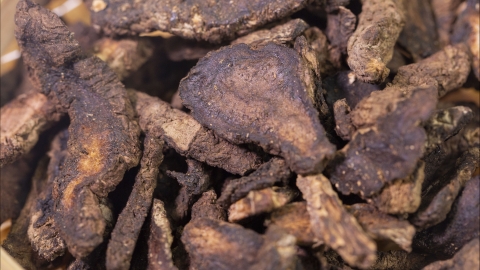The difference between Rehmannia glutinosa and processed Rehmannia glutinosa
The differences between Rehmannia and Prepared Rehmannia generally include differences in processing methods, physical characteristics, properties and meridian tropism, therapeutic effects and indications, and clinical applications.

1. Processing methods: Rehmannia usually refers to either fresh Rehmannia or dried Rehmannia. Fresh Rehmannia is used directly after harvesting and washing, while dried Rehmannia is obtained by drying fresh Rehmannia by exposure to sunlight or through artificial drying. Prepared Rehmannia is processed from dried Rehmannia through steaming with yellow rice wine and other processing techniques, until it becomes black and lustrous both internally and externally, with an oily and moist texture.
2. Physical characteristics: Rehmannia is spindle-shaped or strip-like, with a thin skin, light reddish-yellow surface, and fleshy, easily breakable texture. Dried Rehmannia appears as irregular lumps or long oval shapes, with a glossy black surface and sticky texture. Prepared Rehmannia appears as irregular slices or fragments, with a black, lustrous surface and soft, moist, and flexible texture.
3. Properties and meridian tropism: Rehmannia has a sweet and bitter taste and is cold in nature, affecting the Heart, Liver, and Kidney meridians. Dried Rehmannia is sweet in taste and cold in nature, affecting the Heart, Liver, and Kidney meridians. Prepared Rehmannia is sweet in taste and slightly warm in nature, affecting the Liver and Kidney meridians. Therefore, after processing Rehmannia into Prepared Rehmannia, its cold nature is reduced and becomes mildly warm.
4. Therapeutic effects and indications: Rehmannia clears heat, generates body fluids, cools the blood, and stops bleeding, and is used for conditions such as yin deficiency caused by febrile diseases, deep red tongue, and thirst with irritability. Dried Rehmannia clears heat, cools the blood, nourishes yin, and generates body fluids, and is used for conditions such as heat entering the nutrient blood stage. Prepared Rehmannia nourishes yin, enriches blood, replenishes essence, and fills the bone marrow, and is used for conditions such as liver and kidney yin deficiency, soreness and weakness of the waist and knees, and blood deficiency with sallow complexion. It has a stronger nourishing effect and lacks the heat-clearing action.
5. Clinical applications: Rehmannia is commonly used for acute conditions such as acute febrile diseases. Dried Rehmannia is often used for treating yin deficiency with fever. Prepared Rehmannia is widely used for chronic deficiency conditions, such as regulating menstruation in gynecology, treating male infertility, and addressing kidney deficiency in the elderly. It is a commonly used herb for nourishing kidney yin and enriching blood to treat deficiency syndromes, frequently combined with herbs like Chinese yam (Shanyao) and Cornus fruit (Shanzhuyu) to form formulas such as Liu Wei Di Huang Wan (Six Flavor Rehmannia Pill).
When using these herbs, appropriate materials should be selected based on the patient's specific condition and constitution, following the advice and guidance of a physician.





